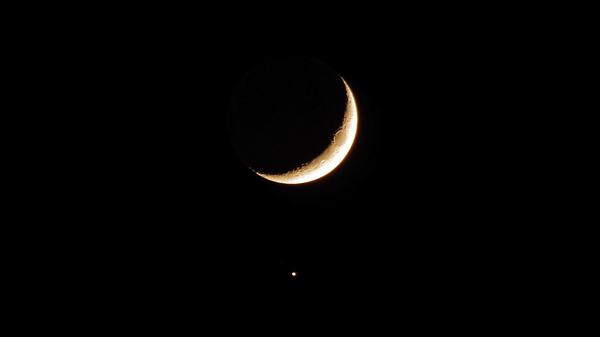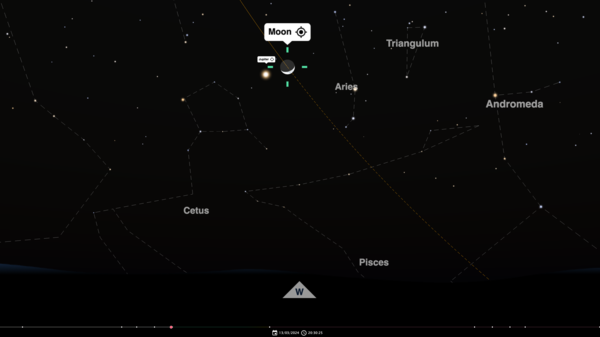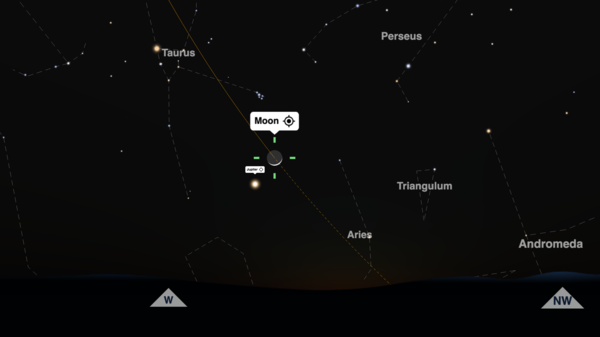Jupiter and Moon Close Approach 2024
Around March 13, the Moon will pair up with Jupiter in the latest of a string of close approaches. The Moon will sweep by again around April 10.
Mar 13 and April 10: Moon and Jupiter Close Again
Don’t miss the next close approaches of the Moon and Jupiter around March 13 and April 10.
Easily visible to the naked eye, there is no need for any extra equipment to see Jupiter next to the Moon.


The Moon and Jupiter will pair up in the night sky over the course of the first four months of 2024. The image is from a previous close approach of Jupiter and the Moon.
©iStockphoto.comDeniz ilgar
One of the simplest ways to notice a planet is when it appears next to the Moon in the night sky. And for the next four months, we will be in for a (repeating) treat.
As the Moon makes its monthly rounds around Earth, it will sweep by Jupiter’s position around January 18, February 14, March 13, and April 10.
See the planets and the Moon in the night sky
Slightly Different Views at Each Location
As you look closer at the images below taken from our Night Sky Map, you may notice slight differences in the size of the lit-up part of the Moon, and the distance between the Moon and Jupiter.
This is because, although all observers will see the Moon and Jupiter in the evening, 9 pm in New York comes 16 hours after 9 pm in Sydney. During this time, the Moon has traveled a little bit further in its orbit around Earth.
Your view also depends on whether you are in the Northern or Southern Hemisphere. The orientation of the Moon and Jupiter varies according to your latitude.
See the Moon’s Orbit
The Moon’s motion around Earth can be revealed by comparing views from one night to the next.
“These events are a great way of appreciating the subtle progress of the Moon as it travels along its orbit,” says Graham Jones, timeanddate.com’s astrophysicist.
“The daily or nightly movement of the Moon from one horizon to the other is easy to notice— but this is caused by Earth’s rotation.”
”Looking at the Moon’s position on successive nights, as it sweeps past Jupiter, shows how the Moon moves steadily eastwards against the background of the stars.”
Different Views for Different Cities
For our comparisons below, we have chosen three cities: New York in the Northern Hemisphere, Singapore near the equator, and Sydney in the Southern Hemisphere. This is because we want everyone—in all locations—to get a sense of what the close approach will look like.
So, check your weather and the time of sunset in your location, and get out and enjoy the Moon and Jupiter pairing up in the sky.
March: Young Crescent Moon


Look up to see a young Waxing Crescent Moon close to Jupiter around March 13 to 14. This screengrab from our Night Sky Map is from New York on March 13 at 8:30 pm. The sizes of the Moon and Jupiter have been artificially exaggerated in order to show their relative positions more clearly.
©timeanddate.com
This month, the young Waxing Crescent Moon will catch up with Jupiter around March 13 to 14. Look out for some earthshine as well.
April: Just after New Moon

Look up to see a young Crescent Moon close to Jupiter around April 10. This screengrab from our Night Sky Map is from New York on April 10 at 8:30 pm. The sizes of the Moon and Jupiter have been artificially exaggerated in order to show their relative positions more clearly.
©timeanddate.com
One to two days after New Moon, depending on your location, a thin sliver of a Waxing Crescent Moon will reach Jupiter again.
It might be a bit tricky to see for stargazers around the equator and in the Southern Hemisphere because the very young Moon is close to the horizon.
May: Jupiter Behind the Sun
The Moon continues its cycle, reaching Jupiter again in May. By then, however, Jupiter will be too close to the Sun, and we won’t see it. The planet passes behind the Sun around May 18.
Do I Need Any Equipment to See Jupiter?
Jupiter, like Venus and Saturn, is one of the easiest planets to spot in the night sky with the naked eye, and you really don’t need any extra equipment to admire the Moon and Jupiter next to each other.
But, if you want to take it up a notch, you might be able to catch Jupiter’s four Galilean Moons with a pair of trained binoculars.
While you’re at it, what about looking at the Moon’s terminator? The terminator is the line on the Moon that separates the dark from the lit-up side, and by looking at it through binoculars, you can explore the mountains and valleys of the Moon’s surface.